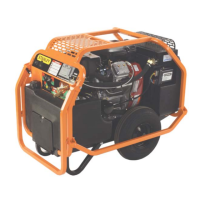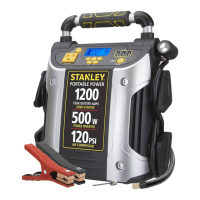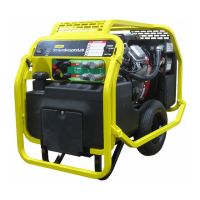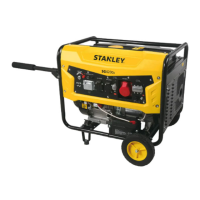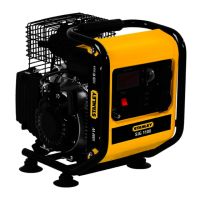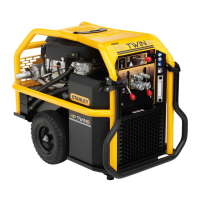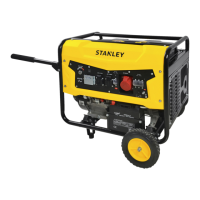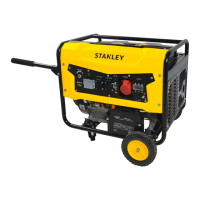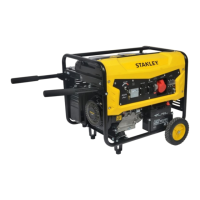STANLEY is a registered trademark of The Stanley Works or its affiliates and are used under license by GXi Outdoor Power LLC.
No part of this publication can be printed or copied without written permission.
13 of 16 Rev. 5/2010
Models: G5000S & G8000S
4. Visually inspect the spark plug. Discard
it if the insulator is cracked, chipped or
fouled.
5. Measure the plug gap with a feeler
gauge. Correct as necessary by care-
fully bending the side electrode. The
gap should be: 0.028 to 0.031 in (0.70 to
0.80 mm)
6. Check that the spark plug washer is in good condition, and thread
the spark plug in by hand to prevent cross-threading.
7. After the spark plug is seated, tighten with a spark plug wrench to
compress the washer.
If installing a new spark plug, tighten 1/2 turn after the spark plug seats
to compress the washer. If reinstalling a used spark plug, tighten 1/8 to
1/4 turn after the spark plug seats to compress the washer.
NOTICE:
The spark plug must be securely tightened. An improperly tightened
spark plug can become very hot and could damage the engine. Use
only the recommended spark plugs or equivalent.
Optional Spark Arrestor Maintenance
If the generator has been running, the muffler will be very hot. Allow it
to cool before proceeding.
The spark arrester must be serviced
every 50 hours to keep it functioning as designed.
Clean the spark arrester as follows:
1. Loosen the screw by the exhaust port of the muffler and remove
the spark arrester.
2. Use a brush to remove carbon deposits from the spark arrester
screen. Inspect the screen for breaks or tears and replace it if
necessary.
3. Install the spark arrester in the reverse order of removal.
Maintenance
Optional Starter Motor Fuse Replacement
If the fuse is blown, the starter motor won’t operate. Turn the engine
switch to the OFF position. Remove the fuse holder cover and replace
the fuse. The specified fuse is 10A.
NOTICE:
Never use a fuse with a
different rating from that
specified. Serious damage
to the electrical system or
fire may result.
TRANSPORTING
When transporting the generator, turn the engine switch and the fuel
valve OFF. Keep the generator level to prevent fuel spillage. Fuel vapor
or spilled fuel may ignite.
Take care not to drop or strike the generator when transporting. Do not
place heavy objects on the generator. When transporting the generator
by loading it on to a vehicle, secure to the generator frame as shown.
DANGER
Contact with a hot engine or
exhaust system can cause
serious burns or fires. Let the
engine cool before transport-
ing or storing the generator.
STORING
Before storing the unit for an extended period:
1. Be sure the storage area is free of excessive humidity and dust.
2. Service according to the table below:
STORAGE TIME Recommended Service Procedure to prevent hard starting:
1 to 2 months Fill with fresh gasoline and add gasoline stabilizer*.
2 months to 1 year Fill with fresh gasoline and add gasoline stabilizer*.
Drain the carburetor float bowl.
1 year or longer
Fill with fresh gasoline and add gasoline stabilizer*.
Drain the carburetor float bowl.
Remove the spark plug. Put a tablespoon of engine oil into the cylinder. Turn the engine
slowly with the recoil starter to distribute the oil. Reinstall the spark plug.
Change the engine oil.
After removal from storage, drain the stored gasoline into a suitable container, and fill with
fresh gasoline before starting.
* Use gasoline stabilizers that are formulated to extend storage life. Contact your authorized STANLEY generator dealer
for conditioner recommendations.
Storage Preparation
1. Drain the carburetor by loosening the drain screw. Drain the gaso-
line into a suitable container. Place 4 ounces of fuel stabilizer in
the fuel tank.
2. Change the engine oil (page 10 ).
3. Remove the spark plug, and pour about a tablespoon of clean
engine oil into the cylinder. Turn the engine several revolutions
slowly with the recoil starter to distribute the oil, then reinstall the
spark plug.
4. Slowly pull the starter grip until resistance is felt. At this point, the
piston is coming up on its compression stroke and both the intake
and exhaust valves are closed. Storing the engine in this position
will help to protect it from internal corrosion.
WARNING
Gasoline is extremely flammable and is explosive under certain
conditions. Perform this task in a well-ventilated area with the
engine stopped. Do not smoke or allow flames or sparks in the
area during this procedure.
SPARK ARRESTOR
SCREW

